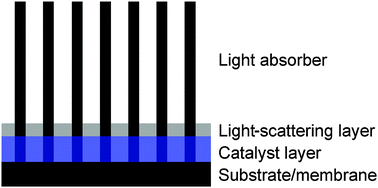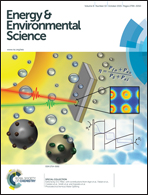Functional integration of Ni–Mo electrocatalysts with Si microwire array photocathodes to simultaneously achieve high fill factors and light-limited photocurrent densities for solar-driven hydrogen evolution†
Abstract
An n+p-Si microwire array coupled with a two-layer catalyst film consisting of Ni–Mo nanopowder and TiO2 light-scattering nanoparticles has been used to simultaneously achieve high fill factors and light-limited photocurrent densities from photocathodes that produce H2(g) directly from sunlight and water. The TiO2 layer scattered light back into the Si microwire array, while optically obscuring the underlying Ni–Mo catalyst film. In turn, the Ni–Mo film had a mass loading sufficient to produce high catalytic activity, on a geometric area basis, for the hydrogen-evolution reaction. The best-performing microwire array devices prepared in this work exhibited short-circuit photocurrent densities of −14.3 mA cm−2, photovoltages of 420 mV, and a fill factor of 0.48 under 1 Sun of simulated solar illumination, whereas the equivalent planar Ni–Mo-coated Si device, without TiO2 scatterers, exhibited negligible photocurrent due to complete light blocking by the Ni–Mo catalyst layer.


 Please wait while we load your content...
Please wait while we load your content...